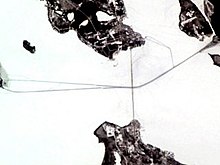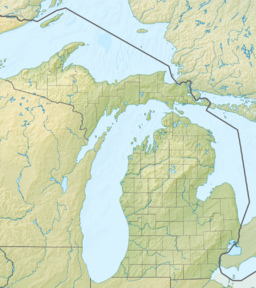
Back Makinak boğazı Azerbaijani Mackinacstroß BAR Макинак (пролив) Bulgarian Straits of Mackinac CEB Mackinac (průliv) Czech Mackinacstrædet Danish Mackinacstraße German Estrechos de Mackinac Spanish Détroit de Mackinac French Strjitte fan Mackinac Frisian
| Straits of Mackinac | |
|---|---|
| |
 Overhead view of the Straits of Mackinac linking Lakes Michigan (left) and Huron (right) | |
| Location | Lake Michigan-Lake Huron |
| Coordinates | 45°48′50″N 84°45′00″W / 45.81389°N 84.75000°W |
| Type | Strait |
| Etymology | Michilimackinac |
| Primary inflows | Lake Michigan |
| Primary outflows | Lake Huron |
| Basin countries | United States |
| Max. depth | 295 ft (90 m) |
| References | [1] |
The Straits of Mackinac (/ˈmækənɔː/ MAK-ə-naw; French: Détroit de Mackinac) are the short waterways between the U.S. state of Michigan's Upper and Lower Peninsulas, traversed by the Mackinac Bridge. The main strait is 3+1⁄2 miles (5.6 kilometers) wide with a maximum depth of 295 feet (90 meters; 49 fathoms),[2] and connects the Great Lakes of Lake Michigan and Lake Huron. Given the large size and configuration of the straits, hydrologically, the two connected lakes are one body of water, studied as Lake Michigan–Huron. Historically, the native Odawa people called the region around the Straits Michilimackinac.
Three islands form the eastern edge of the Straits of Mackinac; two are populated—Bois Blanc Island and Mackinac Island, while the third, Round Island, is uninhabited and a designated wilderness area.[1] The Straits of Mackinac are major shipping lanes, providing passage for raw materials and finished goods and connecting, for instance, the iron mines of Minnesota to the steel mills of Gary, Indiana. Before the railroads reached Chicago from the east, most immigrants arrived in the Midwest and Great Plains by ships on the Great Lakes. The straits are five miles (8 km) wide at their narrowest point, where they are spanned by the Mackinac Bridge. Before the bridge was built, car ferries transported vehicles across the straits. Today passenger-only ferries carry people to Mackinac Island, which does not permit cars. Visitors can take their vehicles on a car ferry to Bois Blanc Island.


The straits are shallow and narrow enough to freeze over in the winter. Navigation is ensured for year-round shipping to the Lower Great Lakes by the use of icebreakers.
The straits were an important Native American and fur trade route. The Straits of Mackinac are named after Mackinac Island. The local Ojibwe Native Americans in the Straits of Mackinac region likened the shape of the island to that of a turtle, so they named the island Mitchimakinak, meaning "Big Turtle".[3] When the British explored the area, they shortened the name to its present form: Mackinac.[4][5]
Located on the southern side of the straits is the town of Mackinaw City, the site of Fort Michilimackinac, a reconstructed French fort founded in 1715, and on the northern side is St. Ignace, site of a French Catholic mission to the Indians, founded in 1671. The eastern end of the straits was controlled by Fort Mackinac on Mackinac Island, a British colonial and early American military base and fur trade center, founded in 1781.
- ^ a b U.S. Geological Survey Geographic Names Information System: Straits of Mackinac
- ^ "Mackinac Bridge History, Facts and Figures".
- ^ Nichols, John D.; Nyholm, Earl (1995). A Concise Dictionary of Minnesota Ojibwe. Minneapolis: University of Minnesota Press.
- ^ Harper, Douglas. "Mackinaw". Online Etymology Dictionary. Retrieved March 8, 2007.
- ^ Ferjutz, Kelly. "Broadcloth, Brocade and Buckskin—Return to the past on Mackinac Island". FrugalFun.com. Retrieved March 8, 2007.
© MMXXIII Rich X Search. We shall prevail. All rights reserved. Rich X Search


